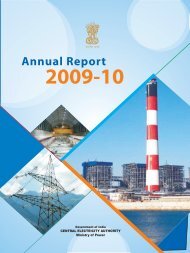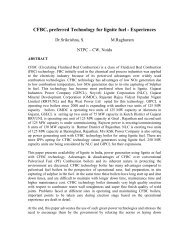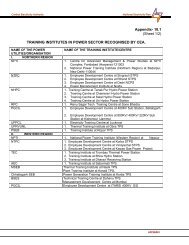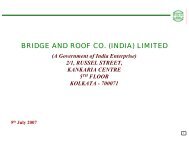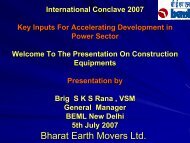performance improvement of infrared flame scanner card ... - Infraline
performance improvement of infrared flame scanner card ... - Infraline
performance improvement of infrared flame scanner card ... - Infraline
You also want an ePaper? Increase the reach of your titles
YUMPU automatically turns print PDFs into web optimized ePapers that Google loves.
PERFORMANCE IMPROVEMENT OF INFRARED FLAME SCANNER<br />
CARD OF 500 MW UNITS AT NTPC LIMITED, FARAKKA<br />
SNEHASIS BHATTACHARYYA , Sr. Supdt. (C&I) , NTPC Ltd, Farakka<br />
ABDUL MAJEED KM ,<br />
Sr. Engineer (C&I) , NTPC Ltd, Farakka<br />
BISWANATH MAJI ,<br />
Sr. Engineer (C&I) , NTPC Ltd, Farakka<br />
ABSTRACT<br />
This paper describes a new method for <strong>performance</strong> <strong>improvement</strong> <strong>of</strong> <strong>infrared</strong> <strong>flame</strong> <strong>scanner</strong> <strong>card</strong> <strong>of</strong> 500 MW units at<br />
NTPC, Farakka. The front and rear pulverized coal fired furnace comprises <strong>of</strong> Infrared <strong>flame</strong> <strong>scanner</strong>s for sensing<br />
& monitoring <strong>of</strong> hydrocarbon <strong>flame</strong> present in the furnace. Each <strong>scanner</strong> head consists <strong>of</strong> a <strong>card</strong> containing <strong>infrared</strong><br />
detector and a high impedance matching amplifier to measure the inherent pulsation & quality <strong>of</strong> the <strong>flame</strong>. The<br />
newly designed and developed standard <strong>infrared</strong> source could replicate the boiler <strong>flame</strong> signal and compared the<br />
outputs <strong>of</strong> the insensitive <strong>card</strong>s against a standard healthy test <strong>card</strong> which greatly improved the reliability <strong>of</strong> <strong>flame</strong><br />
sensing and safety <strong>of</strong> the boiler<br />
INTRODUCTION<br />
The 500 MW Boilers at NTPC / Farakka have a front and rear pulverized coal fired furnace <strong>of</strong> B&W design. The<br />
furnace, a unique <strong>of</strong> its kind in the country, comprises <strong>of</strong> eight elevations with 6 burners in each elevation and 48<br />
Infrared <strong>flame</strong> <strong>scanner</strong>s per boiler for <strong>flame</strong> monitoring <strong>of</strong> these burners. This monitoring is done by SIE Systems,<br />
Italy make UR 600/IR Infrared Flame Scanner .<br />
RADIATION OF A (HYDROCARBON) FIRE<br />
A fire radiates an enormous amount <strong>of</strong> energy <strong>of</strong> which we humans only can see a very small part. As you can see in<br />
the picture-1 below most <strong>of</strong> the energy is invisible to us. The part that we can see is mostly red-yellow in colour<br />
caused by the Carbon in a fire. The invisible IR part <strong>of</strong> the fire we experience as heat. A non-Hydrocarbon such as<br />
Hydrogen burns light blue-transparent because there is no Carbon in the <strong>flame</strong>. It also doesn't have the CO2 peak at<br />
4.4µ and can therefore only be detected with a UV detector.<br />
The CO2 peak in the fire represents less then 2% <strong>of</strong> the total fire energy. A multi sensor Flame Detector that uses<br />
sensors such as UV, near IR, wide band IR etc. has much more sensor input and can therefore be more specific or<br />
less effected by false alarms. E.g. a "UV/visible/wideband IR detector" can detect burning Hydrogen and Metals<br />
besides common Hydrocarbons like Petrol, Wood or Natural Gas but is still very false alarm resistant.<br />
It looks rather static but in reality the fire energy fluctuates rapidly. The Fuel and Oxygen in the uncontrolled fire<br />
constantly burn as in small explosions and then sucks new Fuel and Oxygen to the <strong>flame</strong>s. This process causes the<br />
<strong>flame</strong> flicker. The typical frequency is between 1 and 20 Hz. Most Infrared Flame Detectors use the flicker<br />
frequency as an extra criterion in order to make the detector more reliable.
PERFORMANCE IMPROVEMENT OF INFRARED FLAME SCANNER<br />
CARD OF 500 MW UNITS AT NTPC LIMITED, FARAKKA<br />
CO2<br />
Near IR<br />
Wideband IR<br />
Energy, Kilowatt<br />
UV<br />
Visible<br />
WaveLength,(Micron) 4.4<br />
Picture-1:- Radiation from a hydrocarbon fire<br />
INFRA-RED FLAME SCANNERS<br />
Flame <strong>scanner</strong>s are optical fire detection devices, which are able to detect infra-red and/or ultra violet radiation<br />
given <strong>of</strong>f from a flaming fire.<br />
I.R. Flame Detectors respond to flaming fires emitting light in the <strong>infrared</strong> area <strong>of</strong> the spectrum (modulating at 5 to<br />
30 cycles per second). I.R. Flame Detectors can respond to a fire condition in typically less than 50 milliseconds and<br />
are designed to detect hydrocarbon fires whilst ignoring potential false alarm hazards such as arc welding, nuclear<br />
radiation and x-rays.<br />
The sensor usually incorporates a delayed response, selectable in the range 3-30 seconds, to minimise responses to<br />
non-fire sources <strong>of</strong> radiation. In this way alarms are only generated by a sustained, flickering sources <strong>of</strong> I.R.<br />
radiation - e.g. fire.<br />
The sensitivity <strong>of</strong> Infrared Flame Detectors is affected by the distance <strong>of</strong> the device from the fire source such that, if<br />
a distance is doubled the fire has to be four times as large to be detected. The trigger delay is therefore adjusted to<br />
suit the installation conditions shorter delays for lower mounting, longer delays for higher mounting.<br />
An <strong>infrared</strong> (IR) detector is basically composed <strong>of</strong> a filter and the system is used to screen out unwanted<br />
wavelengths and focus the incoming energy on a photovoltaic or photo resistive cell sensitive to <strong>infrared</strong> radiation.<br />
IR <strong>flame</strong> detectors can respond to the total IR component <strong>of</strong> the <strong>flame</strong> alone or in combination with <strong>flame</strong> flicker in<br />
the frequency range <strong>of</strong> 5 to 30 Hz.
PERFORMANCE IMPROVEMENT OF INFRARED FLAME SCANNER<br />
CARD OF 500 MW UNITS AT NTPC LIMITED, FARAKKA<br />
IR detectors are sensitive to most hydrocarbon fires (liquid, gases and solids). Fires, such as burning metals,<br />
ammonia, hydrogen, and sulphur do not emit significant amounts <strong>of</strong> IR radiation in the 4.4 micron sensitivity range<br />
<strong>of</strong> most IR detectors. Thorough planning is required to apply IR fire detectors to non-hydrocarbon fuelled fire<br />
applications.<br />
CONE OF VISION<br />
The cone <strong>of</strong> vision <strong>of</strong> a <strong>flame</strong> detector depends on the shape and dimensions <strong>of</strong> the lens/housing and the position <strong>of</strong><br />
the sensor. With IR sensors, lamination <strong>of</strong> the filter plays a role and can also limit the cone <strong>of</strong> vision. A wider cone<br />
doesn't automatically mean that the detector is better. It could even be a drawback if the detector has a wide cone <strong>of</strong><br />
vision in case you want to avoid having false alarm sources in the field <strong>of</strong> view. In practice you don't need a angle <strong>of</strong><br />
more than 90°. The cone is three-dimensional and doesn't need to be perfectly cylindrical. The horizontal and<br />
vertical field <strong>of</strong> view are mostly different due to the shape <strong>of</strong> the housing or the location <strong>of</strong> mirrors. (Self check).<br />
Very important is the sensitivity at the 45° edges. This must be minimum 50% <strong>of</strong> the maximum sensitivity on the<br />
central axe. Some detectors have a 70% <strong>performance</strong> here. In reality these detectors have a cone <strong>of</strong> vision that is<br />
wider than 90° but the manufacturer prefers not to tell you. (See picture below).<br />
Picture-2:- cone <strong>of</strong> vision
PERFORMANCE IMPROVEMENT OF INFRARED FLAME SCANNER<br />
CARD OF 500 MW UNITS AT NTPC LIMITED, FARAKKA<br />
Figure 3: Example <strong>of</strong> typical <strong>flame</strong> flicker analysis for <strong>flame</strong> “on” and <strong>flame</strong> “<strong>of</strong>f” (background) condition<br />
The curves in Figure 3 indicate the relative amplitude <strong>of</strong> this radiation at the corresponding <strong>flame</strong> flicker frequency.<br />
The “<strong>flame</strong> on” curve shows a relatively high amplitude in the 50 to 120 Hz range received from the ignition zone <strong>of</strong><br />
the <strong>flame</strong>. The “<strong>flame</strong> <strong>of</strong>f” (background) curve shows these 50 to 120 Hz frequencies at a much lower amplitude.<br />
The cause <strong>of</strong> this difference is that although the “<strong>flame</strong> <strong>of</strong>f” condition receives nearly the same frequencies from<br />
adjacent <strong>flame</strong>s in the background, they are further away from the detector. Therefore, there is less amplitude. This<br />
difference in amplitude at selected frequencies allows the <strong>flame</strong> detection system to discriminate. In a set-up such as<br />
this, where the detector is sighted at the ignition zone <strong>of</strong> the targeted <strong>flame</strong>, it is not uncommon to find that the<br />
lowest frequencies increase dramatically in a “<strong>flame</strong> <strong>of</strong>f” condition. This happens because the ignition zone <strong>of</strong> the<br />
targeted <strong>flame</strong> “masks” the bright background low-frequency radiation while the targeted <strong>flame</strong> is on. When the<br />
targeted <strong>flame</strong> disappears, the background radiation comes into full view is shown in the curve.<br />
BACKGROUND GAIN CONTROL<br />
Infra-red <strong>scanner</strong>s may feature Background Gain Control or BGC. BGC inversely adjusts the Flame Signal Gain<br />
based on <strong>flame</strong> brightness as sighted by the <strong>scanner</strong>. As <strong>flame</strong> brightness increases, automatic gain is decreased,<br />
thereby diminishing the detector’s <strong>flame</strong> signal. Some older detectors use an optical shutter for verification <strong>of</strong> valid<br />
<strong>flame</strong> presence data, in later models this electromechanical shutter is replaced by an electronic self-check circuitry.<br />
This periodically bypasses the photo resistor cell and checks the system for false or corrupted <strong>flame</strong> signal.
PERFORMANCE IMPROVEMENT OF INFRARED FLAME SCANNER<br />
CARD OF 500 MW UNITS AT NTPC LIMITED, FARAKKA<br />
In spite <strong>of</strong> <strong>scanner</strong> tuning for better <strong>flame</strong> monitoring, healthiness <strong>of</strong> the <strong>scanner</strong> plays a vital role. Each <strong>scanner</strong><br />
head assembly consists <strong>of</strong> a <strong>scanner</strong> <strong>card</strong> ( see picture-4) .The <strong>card</strong> consists <strong>of</strong> an <strong>infrared</strong> detector and a high<br />
impedance matching amplifier to measure the inherent pulsation and thus, the quality <strong>of</strong> the <strong>flame</strong>. The accurate<br />
measurement is essential for safe and reliable operation <strong>of</strong> the boiler. Any deterioration in <strong>performance</strong> <strong>of</strong> these<br />
<strong>scanner</strong> <strong>card</strong>s results in low <strong>flame</strong> sensing even when the <strong>flame</strong> condition in the furnace is good and causes<br />
unwarranted elevation trips. The subsequent disturbances in boiler <strong>flame</strong> leads to cascaded tripping <strong>of</strong> other<br />
elevations, unit emergencies and in extreme cases, even unit outages. Over a period <strong>of</strong> continuous use in the<br />
hazardous boiler environment, a lot many <strong>card</strong>s were found to be sensing low <strong>flame</strong> signals and needed immediate<br />
replacement with new <strong>card</strong>s. However, this called for a huge expenditure and was an uneconomical solution.<br />
Picture-4: Scanner head <strong>card</strong> and Newly designed test kit<br />
Earlier <strong>scanner</strong> <strong>card</strong>s were tested with the help <strong>of</strong> a candle light and the output waveform <strong>of</strong> the <strong>card</strong>s were seen in<br />
CRO. Qualitative and quantitative checking <strong>of</strong> the individual <strong>card</strong> was not possible as exact replication <strong>of</strong> <strong>of</strong> the<br />
boiler <strong>flame</strong> was not possible with the candle light. The output wave form was observed with candle light in on and<br />
<strong>of</strong>f conditions with the help <strong>of</strong> obstacles.<br />
Then C&I laboratory has designed and developed a test kit with the help <strong>of</strong> <strong>infrared</strong> emitter source and an electronic<br />
circuit which simulates the boiler <strong>flame</strong> signal in boiler working condition. This test jig provides 250 hz square wave<br />
<strong>infrared</strong> pulses to the <strong>scanner</strong> head <strong>card</strong>. If the output <strong>of</strong> the <strong>card</strong> is above 15 db, the <strong>card</strong> is considered as healthy.<br />
The defective <strong>card</strong> and healthy <strong>card</strong> output responses were given below in figure 5.<br />
C&I Laboratory <strong>of</strong> NTPC, Farakka revamped the existing <strong>card</strong>s which otherwise would have had to be dis<strong>card</strong>ed.<br />
Also, the detailed component level diagram has been developed (see the figure 6.) in the laboratory as manufacturer<br />
had not provided the same. For comparison <strong>of</strong> <strong>performance</strong> The deteriorating components (FET 2N4340, IR<br />
detector IR/2305) have been replaced with new and standard ones. The <strong>card</strong>s were tested again in laboratory and<br />
found working all right . In total 192 <strong>flame</strong> <strong>scanner</strong>s are getting revamped in every year in two 500MW units, which<br />
greatly improved the reliability <strong>of</strong> <strong>flame</strong> sensing and safety <strong>of</strong> the boiler. It has been observed that the average life<br />
span <strong>of</strong> the <strong>card</strong> is 2 years.
PERFORMANCE IMPROVEMENT OF INFRARED FLAME SCANNER<br />
CARD OF 500 MW UNITS AT NTPC LIMITED, FARAKKA<br />
Figure 5. comparison <strong>of</strong> defective <strong>card</strong> reponse(left) versus<br />
healthy <strong>card</strong> response (right) with the help <strong>of</strong> test jig.<br />
Figure 6. Traced circuit diagram <strong>of</strong> the <strong>scanner</strong> head <strong>card</strong>
PERFORMANCE IMPROVEMENT OF INFRARED FLAME SCANNER<br />
CARD OF 500 MW UNITS AT NTPC LIMITED, FARAKKA<br />
SAVINGS<br />
Total <strong>scanner</strong> head <strong>card</strong> population in stage 2 ( 2X 500 MW) = 96 X 2 = 192 no.s<br />
Average failure rate = 28 no.s per year.<br />
A) COST OF EACH CARD ASSEMBLY (AS PER LPP)= 1,080 Euros<br />
COST OF PROCUREMENT OF 28 CARDS = 32,040 Euros<br />
= RS 19.36 Lacs.<br />
B) COST OF REPAIR FOR 28 CARDS: = US $ 2042<br />
=RS.1.02 Lacs (COMPONENTS COST)<br />
DIRECT SAVINGS FROM REPAIR OF 28 CARDS :<br />
RS. 18.34 lacs=28,656 Euros approx.<br />
DIRECT FOREIGN EXCHANGE SAVINGS ON SPARES<br />
FROM THE REPAIR =28,656 Euros per year<br />
(Calculation are made taking 1 Euro=Rs.64/- & 1 US $ = Rs. 50/-)<br />
REFERRENCES<br />
1) B&W Boiler manuals for 500 MW Units.




